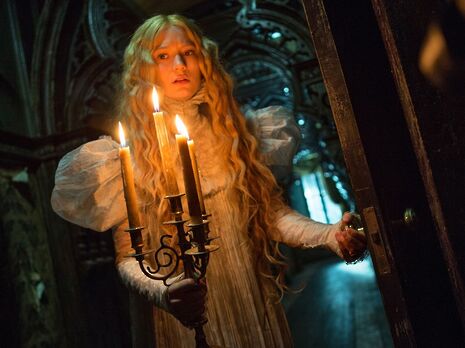Film: Crimson Peak
A storyline bordering on the cliched is saved by “some moments of real brilliance”, writes Oliver Yeates

Opening with Mia Wasikowska’s haunting beckoning to the camera, hand held towards us and eyes piercing the lens, director Del Toro teases us (with haunting caution) to enter his world. Aesthetically, the film is unrivalled; the colours, sets, clothes and symbols are masterful in their vision and their craft. Every aspect of each scene is meticulously imagined. One is almost overwhelmed by the artistic wonder to be found even in the wallpaper, chairs, and curtain embroidery, not to mention the strikingly gothic buildings and exquisite costumes which, from lace to lapel, have been attended to with commendable craftsmanship. The costumes succeed in constituting the Victorian context in which the film is set in a truly beautiful Del Toro fashion.
Inhabiting this world are three strong leads. Hiddleston’s performance as the darkly seductive Thomas Sharpe does the job, but offers nothing special. Playing the film’s heroine, Mia Wasikowska develops a real maturity in her acting, demonstrating a vulnerability which is believable and induces our sympathy; she becomes victim to the very Austen-Brontë worlds she initially recoils from. It is Jessica Chastain’s portrayal of Lucille Sharpe that steals the show; her presence on screen is haunting and menacing, a tribute to the ever-growing versatility of Chastain’s growing body of impressive work. However the rest of the ensemble feels flat and they seemingly exist only for plot purposes. The film would have perhaps felt much more claustrophobic and intense should it have centred wholly on the main twisted triangle of the dark-Sharpe-duo and Wasikowska’s torn Edith Cushing stuck in the middle.
Where Crimson Peak disappoints is its ability to tell stories. Its approach is far too similar to what we’ve seen before and it succumbs to horror-story cliches, from the way it achieves its jump-scares to the (bordering on generic) spindly-violin and heartbeat soundtrack. Having said that, the film visualises ghosts in a truly original way; the depiction of them is chilling and spectacular. The script is awkwardly paced and only when we reach the house itself does the film find a stronger voice. It seems Del Toro was uncertain of the genre, as Crimson Peak isn’t intense enough to justify itself as a horror, but is also too emotionally shallow to be considered a substantial dramatic “gothic romance” (as Hiddleston called it).
The unsatisfactory story as a whole should not overshadow some moments of real brilliance. The climax is spectacular, with an adrenaline that achieves the peak of the film’s thrill - the sequence of Chastain’s pursuit of Wasikowska through the house is genuinely unnerving. Even smaller, seemingly trivial, moments are executed in beautiful flourish, from the opening of a letter, to the taking off of a coat, to the billowing of a cloak when gliding down the stairs. One cannot help but simply want more of the house, however. Its design as a gothic setting of psychological unsettlement is fully realised, and with rooms lined with black-moths for wallpaper and with corridors of almost hypnotising and gothic inception, the film teases a sense of place which is to be relished and craved.
Guillermo Del Toro’s Crimson Peak revives the imagination and fantastical flair seen in his spectacular earlier work, Pan’s Labyrinth, made before he took to a more Hollywood-centric style of film-making. Yet Crimson Peak needed a more weighted story and more convincing character arcs to secure itself as a five-star triumph. Nevertheless, to rate it any lower than I have would be simply insulting to the visual accomplishments of an original vision that Del Toro and his crew have so impeccably translated onto the screen.
 News / Eight Cambridge researchers awarded €17m in ERC research grants27 December 2025
News / Eight Cambridge researchers awarded €17m in ERC research grants27 December 2025 News / Downing investigates ‘mysterious’ underground burial vault 29 December 2025
News / Downing investigates ‘mysterious’ underground burial vault 29 December 2025 Lifestyle / Ask Auntie Alice29 December 2025
Lifestyle / Ask Auntie Alice29 December 2025 Sport / Hard work, heartbreak and hope: international gymnast Maddie Marshall’s journey 29 December 2025
Sport / Hard work, heartbreak and hope: international gymnast Maddie Marshall’s journey 29 December 2025 Interviews / Meet Juan Michel, Cambridge’s multilingual musician29 December 2025
Interviews / Meet Juan Michel, Cambridge’s multilingual musician29 December 2025









